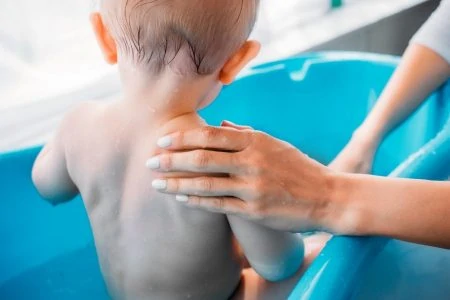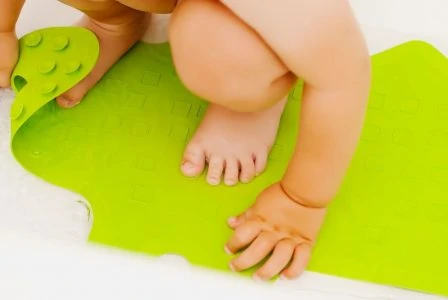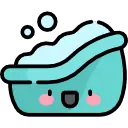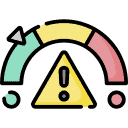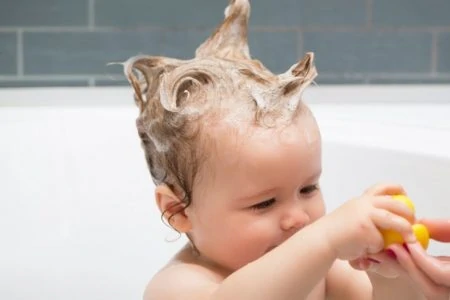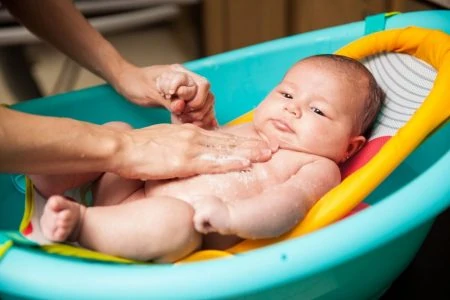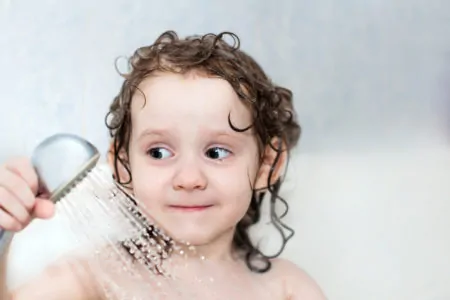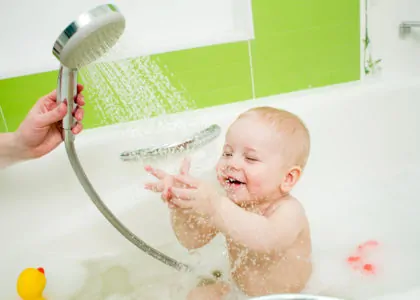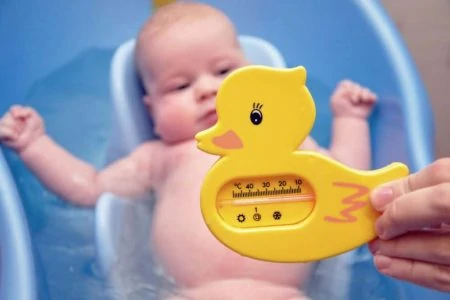The team at Mom Loves Best has bathed countless babies. We learned the ropes and gained confidence. Now, we are here to help you.
We will guide you through the process step-by-step. We also answer common questions so you can enjoy these bonding moments with your little one.
Key Takeaways
- Sponge baths first: Stick to sponge baths until the umbilical cord stump falls off and heals to prevent infection.
- Prep is key: Gather soap, towels, water, and a fresh diaper before you start so you never leave your baby unattended.
- Be gentle: Clean one area at a time, paying attention to neck folds and the diaper area; avoid soap on sensitive genitals.
- Safety first: Keep the room warm, test water temperature with your wrist, and keep a hand on your baby at all times.
The First Weeks
A sponge bath is the best way to clean your baby during the first few weeks. Your baby likely still has their umbilical cord stump. You must keep this area dry to help it heal.
Avoid tub baths for now. Even if you towel dry the stump after a soak, moisture can remain deep in the crevice. This prolongs healing and increases infection risks.
Take Note
How to Give Your Baby a Sponge Bath
Gather your supplies before you undress the baby. You do not want to realize you forgot the towel while holding a shivering, naked infant.
Here is what you need:
- Mild, baby-safe soap.
- Shampoo (optional).
- Large bowl or basin for water.
- Clean clothes and a fresh diaper.
- Warm water.
- Baby lotion.
- Changing pad or soft blanket.
- Two or three washcloths.
- Cotton balls.
- Plastic cup for rinsing.
- Two towels (hooded ones are great).
1. Prepare the Station
Place the changing pad or blanket on a flat, warm surface. You can use a changing table, a bed, or even the floor. Ensure the room is warm (around 75 degrees Fahrenheit) so your baby doesn’t get cold.
Always keep a hand on your baby. Newborns cannot roll yet, but they can wiggle off high surfaces.
2. Undress Carefully
Remove clothes but leave the diaper on for now. Babies are unpredictable, and you want to avoid accidents on your clean towel.
Wrap your baby in a towel to keep them warm. Talk softly to them. Tell them what you are doing. This soothes them and helps you bond.
3. Wipe Gently
Dip your cloth in warm water and wring it out. It should be damp, not dripping.
Start with the face. Use plain water (no soap) for the face. Wipe the eyes from the inside corner out. Use a fresh section of the cloth or a clean cotton ball for each eye to prevent spreading any potential infection.
Clean around the mouth, chin, and neck folds. Milk often hides in those chubby neck rolls, so check carefully.
Uncover the chest and wipe it down. If you use soap, apply a tiny amount to the cloth. Rinse the soap off with a fresh, damp cloth.
Remember
Check fingers and toes. Lint or hair can wrap around tiny digits and cut off circulation. This is called a hair tourniquet.
4. Clean the Diaper Area
Remove the diaper last. Clean the genital area gently. Diaper rashes often start because of bacteria hidden in skin folds.
Wipe front to back for girls to prevent infection. For boys, wipe around the penis and scrotum. If you have a circumcised boy, follow your pediatrician’s care instructions and avoid soap until it heals.
5. Shampoo (Optional)
Newborns do not need shampoo often. If you choose to wash their hair, hold your baby in a football hold. Support their head and neck over the basin.
Use a plastic cup to pour warm water over their head. Pour from front to back to keep water out of their eyes.
Add a drop of shampoo and massage gently. Rinse thoroughly.
6. Dry and Lotion
Wrap your baby in a hooded towel immediately. Pat them dry; do not rub. Rubbing can irritate sensitive newborn skin.
If your baby has peeling skin (common in newborns), apply a mild baby lotion. This helps hydrate the skin as it sheds.
7. Cord Care
Pat the umbilical cord stump gently with a clean, damp cloth. Clean around the base. Do not pull or tug on the cord.
Dress your baby in loose clothing. A loose T-shirt allows airflow, which helps the stump dry and fall off faster (2). Fold the diaper down so it does not rub against the stump.
How Often Should You Bathe Your Baby?
You do not need to bathe a newborn daily. A sponge bath two or three times a week is plenty. However, you should wash their face, neck, and diaper area daily.
Bathing Your Baby in a Tub
Once the cord stump falls off and the site heals, you can graduate to tub baths.
Some babies love the freedom of the water. Others feel insecure and may cry. Be patient. It takes time for them to adjust.
Pro Tip
Gather your supplies:
- Baby bathtub or clean sink.
- Two towels.
- Washcloth or soft sponge.
- Mild soap and shampoo.
- Cup for rinsing.
- Clean diaper and clothes.
1. Prepare the Bath
Fill the tub with 2 to 3 inches of warm water. Test the temperature with your wrist or elbow. It should feel warm, not hot.
If you use a sink or a hard plastic tub, place a towel or non-slip mat at the bottom. This prevents sliding and insulates your baby against the cold plastic.
2. Lower Baby In
Undress your baby completely. Support their head and neck with your non-dominant arm. Use your other hand to support their bottom.
Lower them feet-first into the water gently. Speak calmly to reassure them.
3. Wash the Body
Use your hand or a cup to pour water over their chest to keep them warm.
Wash from the top down. Start with the face (water only). Move to the neck, chest, arms, and legs. Save the diaper area for last.
If you use soap, put a small amount on your washcloth. Wash inside the folds of the neck, armpits, and groin. Rinse well.
4. Shampoo Time
Wash hair last so your baby doesn’t sit with a wet head for the whole bath.
Lean your baby back slightly. Support their neck. Pour water gently over the hair. Be careful not to let soapy water run into their eyes. Use your hand to shield their forehead.
5. Rinse and Exit
Rinse all soap off your baby with fresh water from the tap or a separate cup.
Lift your baby out of the tub using a secure grip. Babies are extremely slippery when wet. Wrap them immediately in a towel.
6. After-Bath Care
Pat your baby dry thoroughly. Pay attention to skin folds. Moisture left in folds can cause irritation. Apply lotion if needed, put on a fresh diaper, and dress them.
Help Your Baby Enjoy Bathtime
If your baby hates the bath, do not stress. It is common. Try these tips to make it a happier experience:
- Check the temperature: If the water is too cool, babies will cry. Aim for around 100 degrees Fahrenheit.
- Time it right: Avoid baths when your baby is hungry or overtired.
- Secure the hold: Babies cry when they feel like they are falling. Hold them firmly.
- Add toys: A simple cup or floating toy can be a great distraction.
- Be playful: Sing songs or talk to your baby. Your voice is their favorite sound (3).
